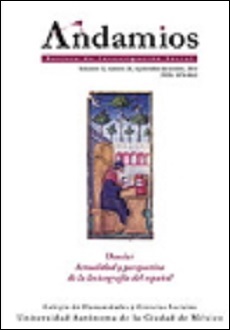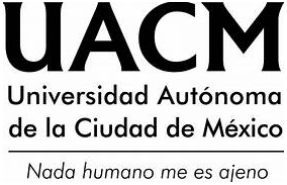Recreate Reality: the Emergence of Ethnographic Film at the Academy
DOI:
https://doi.org/10.29092/uacm.v11i26.208Keywords:
Anthropology, Documentary, Ethnographic Cinema, Meaning, RealityAbstract
This paper discusses the emergence of ethnographic film in the academy as a conceptual encouragement for Anthropology and identifies resistances to quality filmmaking framed in this discipline. It argues that ethnographic filmmaking should put the specificity of film activity before any pedagogical or illustrative aims. In short, it believes that reality must precede the search for meaning.
Downloads
References
Ardevol, E. (2006), La búsqueda de una mirada, Barcelona: Universitat Oberta de Catalunya (UOC).
Barbash, I., Taylor, L. (1996), “Reframing Ethnographic Film: A ‘Conversation’ with David MacDougall and Judith MacDougall”, en American Anthropologist, vol. 98, núm. 2, junio, Arlington, VA: American Anthropological Association/Wiley, pp. 371-387.
Bergala, A. (2007), La hipótesis del cine. Pequeño tratado sobre la transmisión del cine en la escuela y fuera de ella, Barcelona: Laertes.
Bergson, H. (2007), La evolución creadora, Buenos Aires: Cactus.
Crawford, P. I. (1992), “Film as Discourse: the Invention of Anthropological Realities”, en Peter Ian Crawford (ed.), Film as Ethnography, Manchester: Manchester University Press, pp. 66-82.
Csikszentmihalyi, M. (1998), Finding Flow: The Psychology of Engagement With Everyday Life, Nueva York: Basic Books.
Deleuze, G. (2009), Cine i. Bergson y las imágenes, Buenos Aires: Cactus.
____(1987), “Qu’est-ce que l’acte de création”, conferencia pronunciada el 17 de marzo en La Fémis [¿Qué es el acto de creación?, trad. de Bettina Prezioso, Buenos Aires: Fundación femis, 2003].
González-Abrisketa, O. (2011), “Azar y creatividad son cuestiones de método”, en Ankulegi. Revista de Antropología Social, núm. 15, San Sebastián: Ankulegi Asociación Vasca de Antropología, pp. 47-56.
Harris, M. (1979), Cultural Materialism. The Struggle for a Science of Culture, Nueva York: Random House.
Latour, B. (2008), Reensamblar lo social. Una introducción a la teoría del actor-red, Buenos Aires: Manantial.
Lutkehaus, N. C. (1989), “‘Excuse Me, Everything is not All Right’: On Ethnography, Film, and Representation: An Interview with Filmmaker Dennis O’Rourke”, en Cultural Anthropology, vol. 4, núm. 4, noviembre, Arlington, va: Society for Cultural Anthropology, pp. 422-437.
MacDougall, D. (1995), “¿De quién es la historia?”, en Elisenda Ardevol y Luis Pérez (eds.), Imagen y cultura: Perspectivas del cine etnográfico, Granada: Biblioteca de Etnología, pp. 401-422.
Minh-ha, T. (1993), “The Totalizing Quest of Meaning”, en Michael Renov (ed.), Theorizing Documentary, Nueva York-Londres: Routledge, pp. 90-107.
Moore, H. (1994), “Trinh T. Minh-ha Observed: Anthropology and Others”, en Lucien Taylor (ed.), Visualizing Theory. Selected Essays from v. a. r. 1900-1994, Londres-Nueva York: Routledge, pp. 115-125.
Nattiez, J.-J. (1990), Music and Discourse: Toward a Semiology of Music, Princeton, nj: Princeton University Press.
O’Rourke, D. (1999), “On the Making of Cannibal Tours”, mimeo, disponible en línea en www.cameraworklimited.com/get/58. pdf. 19 de agosto de 2012.
Pike, K. L. (1967), Language in Relation to a Unified Theory of Structure of Human Behavior, 2a ed., La Haya: Mouton.
Prigogine, I., Stengers, I. (1990), Entre el tiempo y la eternidad, Madrid: Alianza.
Rollwagen, J. R. (1988), “The Role of Anthropological Theory in ‘Ethnographic’ Filmmaking”, en Jack R. Rollwagen (ed.), Anthropological Filmmaking, Amsterdam: Hardwood Academic Publishers, pp. 287-315.
Rouch, J. (2003), “The Man and the Camera”, en Paul Hockings (ed.), Principles of Visual Anthropology, Berlin: Mounton de Gruyter, pp. 79-98.
Ruby, J. (2000), “Exposing Yourself: Reflexivity, Anthropology, and Film”, en Picturing Culture: Explorations of Film and Anthropology, Chicago: University of Chicago Press, pp. 151-180.
____(1996), “Visual Anthropology”, en D. Levinson y M. Ember, (eds.), Encyclopedia of Cultural Anthropology, vol. 4, Nueva York: Henry Holt and Co., pp. 1345-1351.
Sontag, S. (1984), Contra la interpretación y otros ensayos, Barcelona: Seix Barral.
Žižek, S. (2004), “Fotografía, documento, realidad: una ficción más real que la realidad misma”, en Brumaria. Documentos 70. Disponible en línea en http://altediciones.com/brumaria70.htm. 19 de agosto de 2012.
Filmografía
Gadner, R. (1986), Forest of Bliss, Chicago: Film Studies Center, color, 90 min.
Godard, J.-L. (1963), Le mépris, París-Roma: Les Films Concordia/Rome Paris Films/Compagnia Cinematografica Champion, color, 103min.
____(1962), Vivre sa vie, Francia: Les films de la Pleiáde/Pathé Consortium Cinéma, blanco y negro, 83 min.
Jarmush, J. (1984), Stranger than Paradise, eua-Alemania: Cinesthesia Productions/Grokenberger Film Produktion/Zweites Deutsches Fernsehen (zdf), blanco y negro, 88 min.
Kjøs, H. K., Grindaker, K. (2008), Harvesting the Wasteland, Noruega: Skofteland Film as, color, 58 min.
Leth, J., von Trier, L. (2003), The Five Obstructions (De Fem Benspænd), Dinamarca: Almaz Film Productions/Panic Productions/Wajnbrosse Productions/Zentropa Real, color, 90 min.
Minh-ha, T. T. (1982), Reassemblage: From the Firelight to the Screen, Nueva York-Senegal: Women Make Movies, color, 40 min.
O’Rourke, D. (1987), Cannibal Tours, Australia: Institute of Papua New Guinea Studios, color, 72 min.
Rouch, J. (1965), La chasse au lion à l’arc, Francia: Les Films de la Pléiade/Comité du Film Éthnographique, blanco y negro, 80 min.
____(1952), Bataille sur le grand fleuve, Dakkar-París: Institut Fondamental d’Afrique Noire (IFAN)/Jean Rouch/Centre National de la Recherche Scientifique (CNRS), color, 33 min.
Published
Issue
Section
License
This Journal is licensed under Creative Commons Mexico 2.5. It is allowed to reproduce and disseminate the contents of the Journal for educational or research purposes, not for profit, as long as they are not mutilated and cite the source (Andamios, Revista de Investigación Social) and the author.
The copyright of the articles published in Andamios, Revista de Investigación Social are transferred by the author(s) to Universidad Autónoma de la Ciudad de México when the originals have been accepted, so that they are published and distributed both in the printed and electronic versions of the Journal. However, as established by law, the author(s) retains their moral rights. The author(s) will receive a form of assignment of copyright that they must to sign when their original has been accepted. In the case of collective articles, the signature of one of the authors will suffice, provided that the latter has obtained the consent of the others.
Authors may use the material of their article in other works or books published by themselves, with the condition of quoting Andamios as the original source of the texts.
The articles contained in this publication are the responsibility of their authors and do not compromise the official position of Andamios, Revista de Investigación Social of the Universidad Autónoma de la Ciudad de México.


